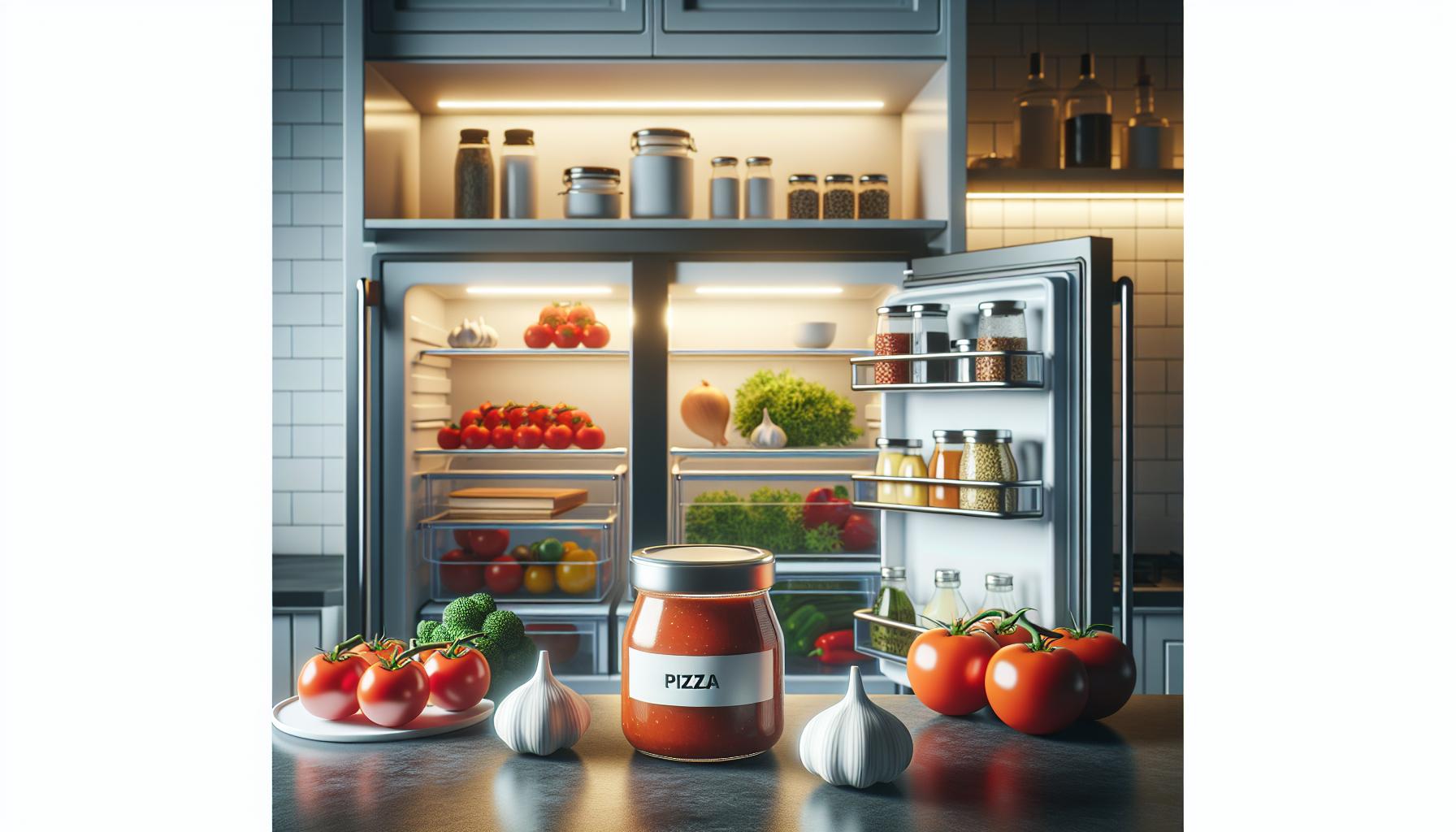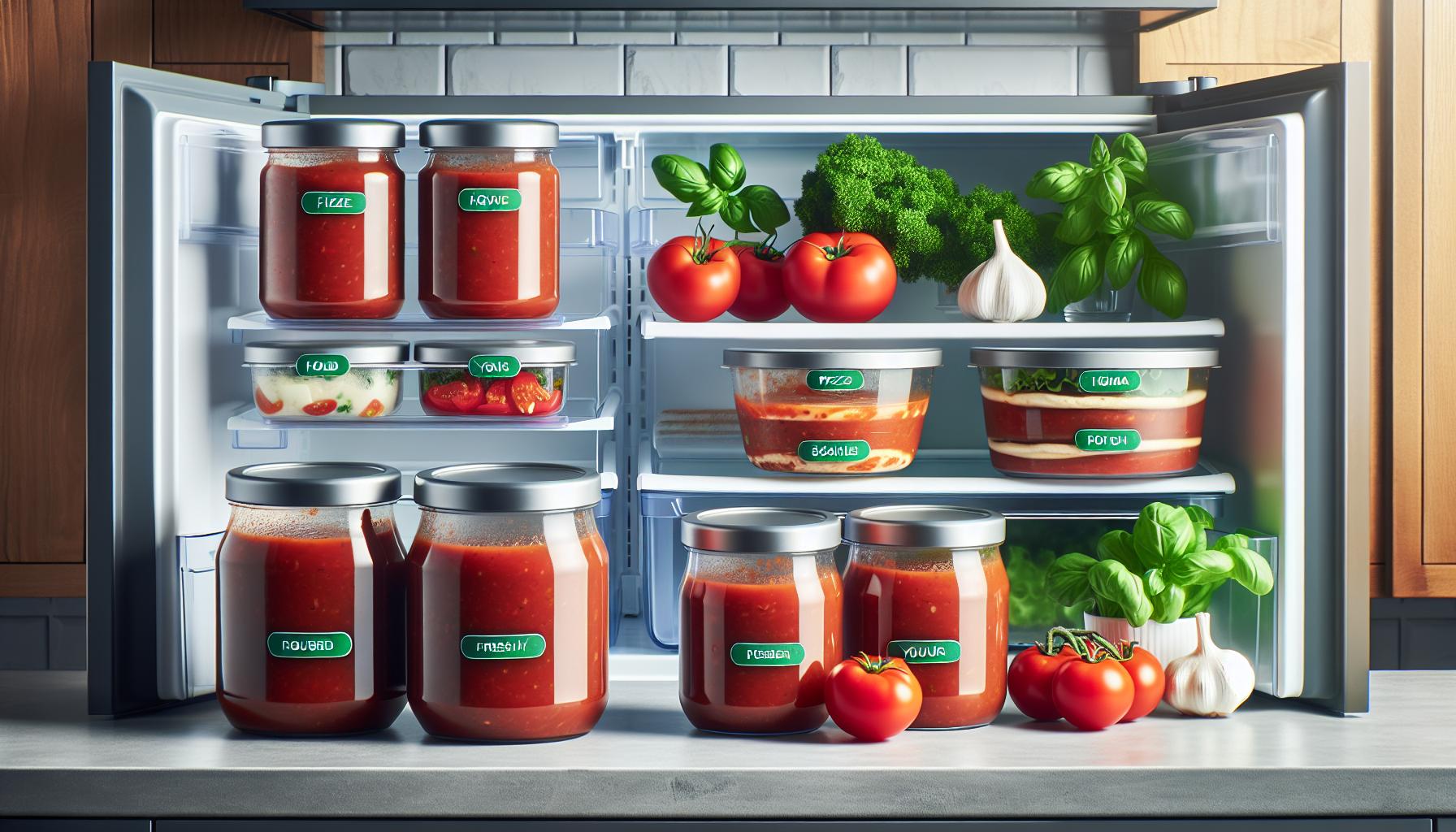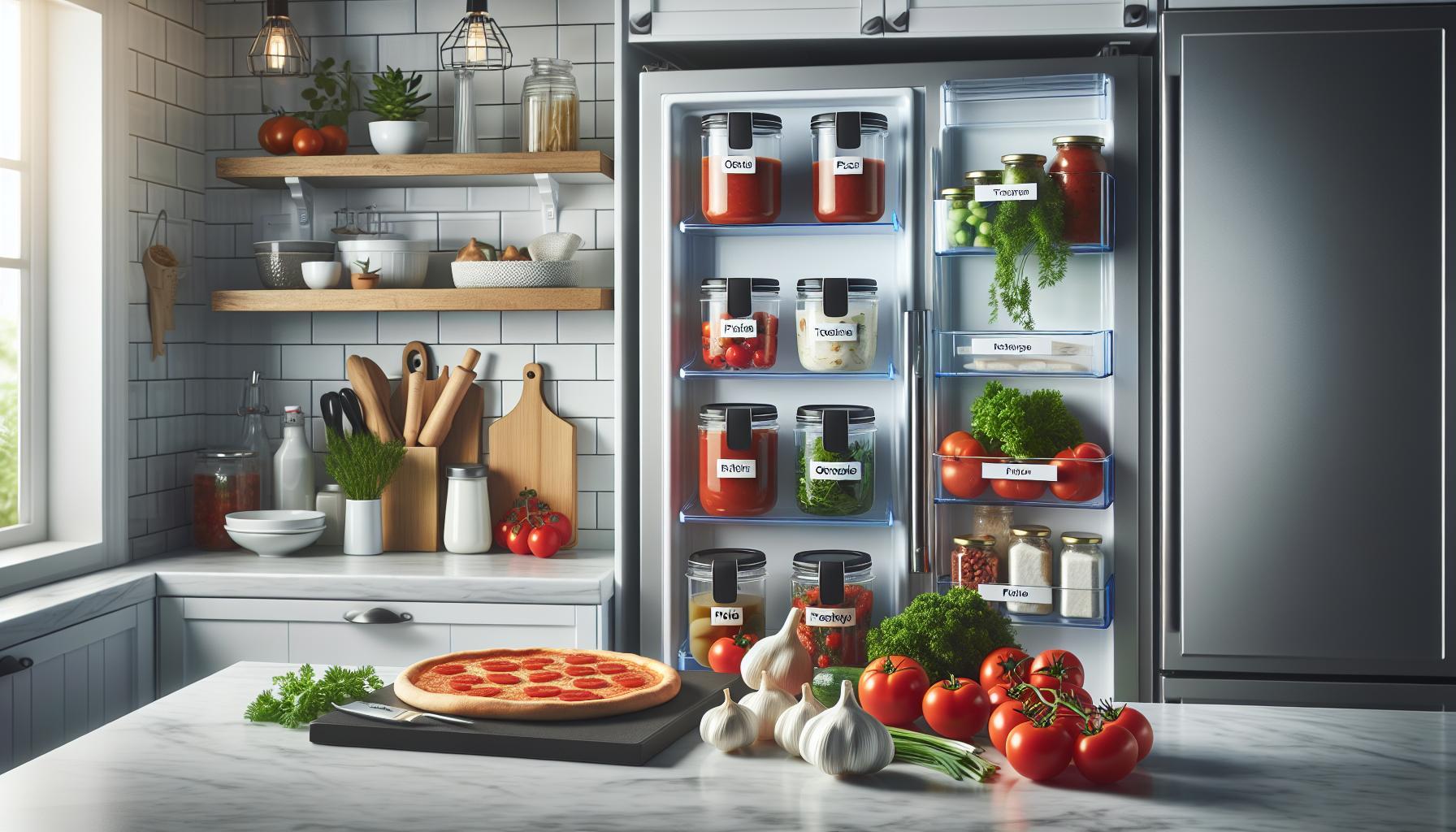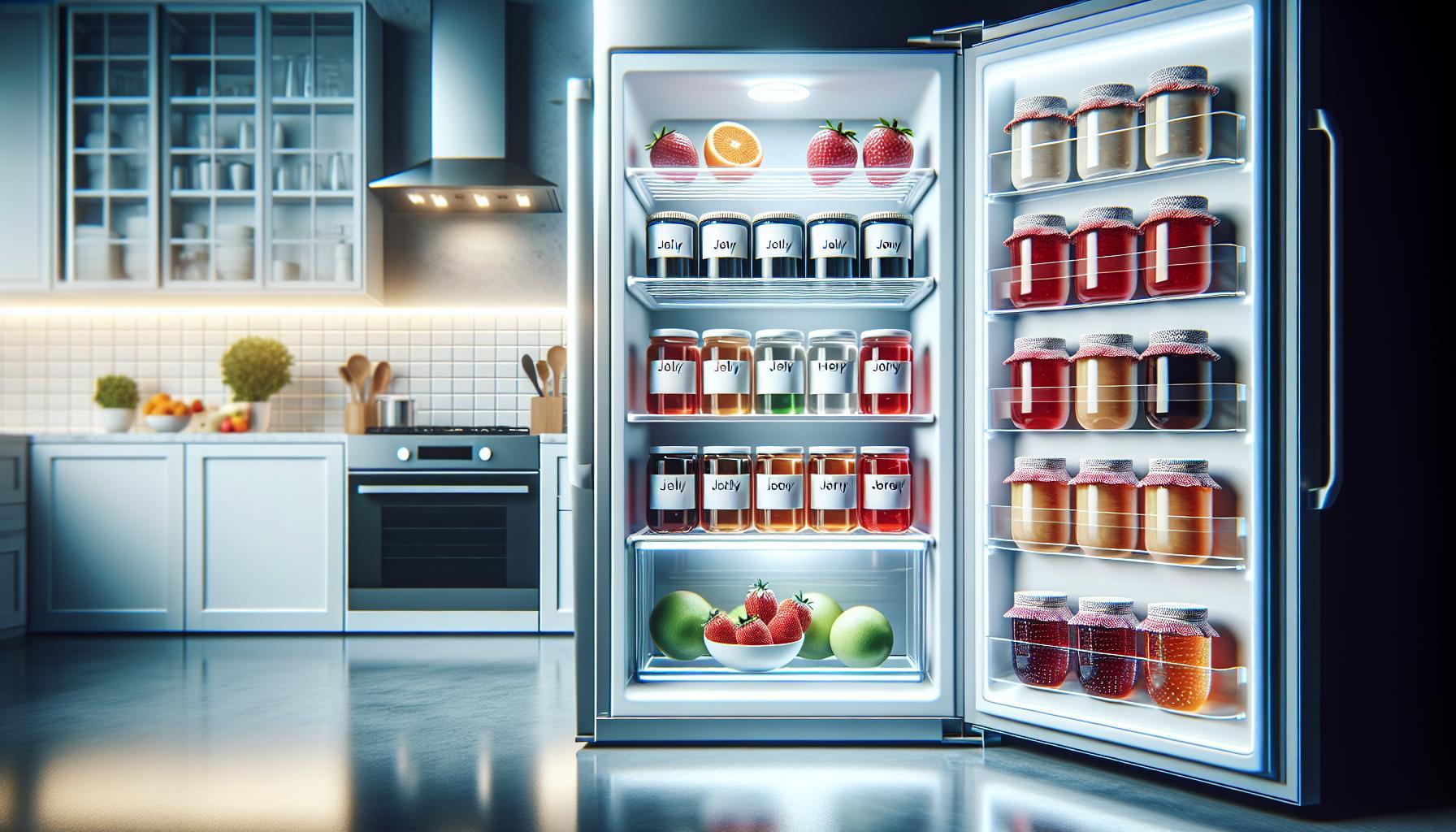Did you know that properly stored pizza sauce can enhance your meals and help you avoid food waste? Many home cooks might not realize that pizza sauce, whether homemade or store-bought, has specific storage guidelines that can maximize its freshness. Understanding how long pizza sauce lasts in the fridge is crucial for ensuring both flavor and safety.
With opened jars sitting in the refrigerator, you’re likely asking yourself: “Is my sauce still good?” Navigating the potential for spoilage can be daunting, especially when you want to enjoy that perfect slice without any worries. In this guide, we will provide you with clear timelines and effective storage tips to keep your pizza sauce in peak condition. Whether you’re preparing for a pizza night or simply want to incorporate versatile sauces into your dishes, knowing how to handle your pizza sauce is essential for maintaining a delicious and safe kitchen. Keep reading to learn how to avoid spoilage today!
How Long Can You Store Pizza Sauce?
Pizza sauce, a staple in many kitchens, can bring life to your favorite dishes, but understanding how long it lasts is essential for both flavor and food safety. Generally, opened pizza sauce can be safely stored in the refrigerator for about 5 to 7 days. This time frame is crucial because, like many tomato-based sauces, it is susceptible to spoilage due to its high moisture and acidity content[3[3].
For those who want to extend the shelf life of their pizza sauce, freezing is an excellent option. Properly stored in an airtight container or heavy-duty freezer bag, pizza sauce can be frozen for up to 3 months without significant loss of flavor or quality. To ensure optimal freshness, it’s a good practice to label your containers with the date before freezing[2[2]. When you’re ready to use it, thawing frozen pizza sauce should be done in the refrigerator overnight or by using the defrost function on your microwave[1[1].
By monitoring how long your pizza sauce has been stored and utilizing proper freezing techniques, you can keep your culinary experiences vibrant and safe. Remember, the signs of spoilage such as off-odors, discoloration, or mold are indicators that the sauce should be discarded, regardless of storage time. Taking these precautions will ensure that your pizza nights remain enjoyable and worry-free.
Understanding Pizza Sauce Spoilage Signs
When it comes to ensuring the freshness of your pizza sauce, recognizing spoilage signs is key to maintaining both safety and flavor. Standard tomato-based sauces, including pizza sauce, are prone to spoilage due to their moisture and acidity. Inspecting your sauce regularly can help you avoid using something that could make you or your loved ones sick.
Start by observing the visual aspect of the sauce. Fresh pizza sauce should have a bright red color. If you notice any discoloration-particularly brown or dark patches-this could indicate oxidation or microbial growth. Additionally, check for any mold. Even a small amount of mold on the surface can signify that the entire batch is unsafe to eat, so it’s best to err on the side of caution and discard it.
Next, give it a whiff. Fresh pizza sauce should carry a pleasant, tangy aroma. If it gives off a sour or off-putting smell, this is a strong indicator that spoilage has occurred. Also, consider the texture: fresh pizza sauce should be smooth and slightly chunky. If the sauce becomes overly watery or develops an unusual consistency, it’s a sign that it may have gone bad.
Finally, remember that while spoilage signs are your first line of defense, relying on timeframes is equally important. Opened pizza sauce typically lasts in the fridge for about 5 to 7 days. If you can’t remember when you opened the jar or you’re doubting its freshness, it’s safer to throw it away than to risk consuming spoiled food. By keeping an eye out for these spoilage signs, you can ensure that your pizza sauce remains not only delicious but safe to enjoy.
Proper Storage Methods for Pizza Sauce
To maximize the freshness and safety of your pizza sauce, proper storage techniques are essential. A few simple practices can significantly extend the shelf life of both homemade and store-bought varieties, ensuring that every spoonful is as flavorful as the day it was made.
First, once you’ve opened a jar of store-bought pizza sauce or prepared your own, always transfer any unused sauce into a clean, airtight container. Resealing the original container may not suffice; air exposure can lead to oxidation and spoilage. To adequately preserve the sauce, consider using glass or BPA-free plastic containers that keep out air and moisture. Be sure to label the container with the date of opening or preparation, allowing you to track freshness easily.
When storing pizza sauce in the refrigerator, keep it at a consistent temperature of 40°F (4°C) or below. Place it on a shelf rather than in the door, as the latter can be subject to temperature fluctuations each time it is opened. If you anticipate not using the sauce within 5 to 7 days, freezing is an excellent option. Divide the sauce into smaller portions-ideal for single-use meals or recipes-and store them in freezer-safe bags or containers. Remember to remove as much air as possible before sealing to prevent freezer burn.
If you decide to freeze pizza sauce, be sure to label the containers with the date and contents. Homemade sauces can typically last for up to 3 months in the freezer, while store-bought sauces generally maintain their quality for 6 to 12 months. When you’re ready to enjoy your frozen sauce, thawing can be done safely in the refrigerator overnight or by placing the sealed container in cool water. Avoid using a microwave for thawing, as uneven heating can create hot spots conducive to bacterial growth. By following these straightforward storage methods, you can enjoy your pizza sauce at its best and avoid unnecessary waste.
How to Freeze Pizza Sauce Effectively
Freezing pizza sauce is an ideal solution to prolong its shelf life while retaining its flavor and quality. With proper freezing techniques, you can enjoy the sauce whenever you crave pizza without worrying about spoilage. The key to successful freezing lies in preparation and packaging, ensuring that the sauce remains fresh for future use.
Begin by allowing your pizza sauce to cool to room temperature if it was cooked. This step is crucial to prevent condensation in the packaging, which could lead to ice crystals and affect the sauce’s texture. Once cooled, portion the sauce into smaller amounts that suit your needs, such as 1-cup servings or even individual portions. This way, you can easily thaw only what you need, minimizing waste.
Packaging Your Sauce
Choose suitable containers for freezing – freezer-safe bags, plastic containers, or glass jars work well. If using freezer bags, squeeze out as much air as possible before sealing to prevent freezer burn. If using containers, leave some space at the top, as liquids expand when frozen. Clearly label each container with the date and contents, which will make it easier to track freshness down the line.
Freezing Duration
Generally, homemade pizza sauce lasts up to 3 months in the freezer, while store-bought sauces can maintain their best quality for 6 to 12 months. Regularly check your frozen sauce, and consider organizing it by date to ensure you’re using the oldest containers first. To make the most of your frozen pizza sauce, remember to incorporate it into your meal planning, making it a quick and easy addition to pasta dishes, casseroles, and of course, pizzas.
By effectively freezing your pizza sauce, you can enjoy the rich flavors of your favorite dish without sacrificing quality, ensuring fresh, ready-to-use sauce is always at your fingertips.
Thawing Frozen Pizza Sauce Safely
Thawing frozen pizza sauce can be a straightforward process, but it’s essential to do it safely to maintain flavor and prevent spoilage. The best approach is to plan ahead and allow the sauce to transition from the freezer to the refrigerator. This gradual thawing method helps preserve the sauce’s quality and makes it easy to incorporate into your recipes.
Start by transferring the frozen pizza sauce container from the freezer to the refrigerator. Depending on the amount you have, this may take anywhere from a few hours to overnight. This method not only keeps the sauce at a safe temperature during the thawing process but also allows for an even reconstitution of flavors. Once thawed, the pizza sauce can remain in the refrigerator for about 3 to 5 days, so be sure to use it within this timeframe.
For those in a hurry, you can use the cold water method for quicker thawing. Ensure the sauce is sealed in a waterproof container or freezer bag, then submerge it in a bowl of cold water, changing the water every 30 minutes. This method typically takes about one to two hours, depending on the volume of sauce. Never thaw pizza sauce at room temperature, as this can encourage bacterial growth and lead to spoilage.
If you’re still pressed for time, the microwave can be an option for thawing, though it may affect the texture slightly. Use the defrost function, checking and stirring the sauce frequently to ensure it heats evenly. Once thawed, use the sauce immediately, as microwaving can warm it to temperatures that may promote spoilage if not used right away. Always prioritize food safety to enjoy your homemade or store-bought pizza sauce at its best.
Homemade vs. Store-Bought Pizza Sauce Shelf Life
Making pizza at home often leads to the creation of delicious sauces, but understanding the shelf life of both homemade and store-bought varieties can ensure you enjoy them at their best. Store-bought pizza sauce typically contains preservatives that extend its freshness, allowing it to last approximately 5 to 7 days in the refrigerator once opened. In contrast, homemade pizza sauce, which lacks preservatives, generally has a shorter shelf life of around 3 to 5 days when stored properly in the fridge.
Factors Affecting Shelf Life
The differences in shelf life can often be attributed to the ingredients used and the method of preparation. Homemade sauces may include fresh herbs and vegetables that can spoil faster than the processed components found in store-bought options. To maximize the shelf life of homemade pizza sauce, ensure that it is stored immediately after preparation in an airtight container and kept at a consistent refrigeration temperature of 35°F to 40°F.
When it comes to freezing, both types of sauce can be extended well beyond their refrigerator shelf life. Store-bought sauce can be frozen for up to 6 months, while homemade sauce should also not exceed this time frame for optimal flavor and texture. Proper freezing techniques, such as using airtight containers or freezer bags, are vital to prevent freezer burn and maintain the sauce’s quality.
Understanding these factors will not only help in preventing spoilage but also enhance your pizza-making experience by ensuring that your sauces remain flavorful and safe to consume. Whether you opt for the convenience of store-bought sauce or the fresh taste of homemade varieties, being mindful of their shelf life is crucial in your cooking journey.
Tips for Extending Pizza Sauce Freshness
Keeping your pizza sauce fresh for as long as possible ensures that every dish you create tastes its best. Luckily, there are several effective strategies to extend the shelf life of both homemade and store-bought pizza sauce. One key practice is to always store the sauce in an airtight container. This prevents exposure to air, which can lead to oxidation and spoilage. Ideally, use glass jars or plastic containers that seal tightly, minimizing the chances of contaminants getting in.
Another important aspect is monitoring the temperature of your refrigerator. Keeping your refrigerator at a consistent temperature between 35°F to 40°F is essential to inhibit bacterial growth. Consider using a thermometer to ensure the temperature is accurate, particularly if your refrigerator tends to fluctuate. When storing sauce, place it in the back of the fridge where it tends to be the coldest, rather than in the door.
If you know you’ll have leftover sauce that won’t be used within a week, freezing is an excellent option. Divide the sauce into smaller portions before freezing to make it easier to thaw just what you need later. Use freezer-safe containers or resealable freezer bags, and remember to label them with the date to avoid keeping them in the freezer longer than six months. This method not only preserves freshness but also allows for convenient meal preparation at a later date.
Finally, consider adding a splash of acidity, such as lemon juice or vinegar, to homemade sauce. This can help to enhance the flavor and may also contribute to a slightly longer shelf life. Additionally, practice good hygiene while handling the sauce; always use clean utensils to avoid contaminating the container. By implementing these tips, you can significantly extend the freshness of your pizza sauce, ensuring that it remains safe and delicious for all your pizza nights.
Using Leftover Pizza Sauce Creatively
Using leftover pizza sauce can be a game-changer in the kitchen, transforming ordinary meals into something extraordinary while reducing food waste. This versatile sauce is not just for pizza; it can elevate a variety of dishes and offer bold flavors to your culinary creations.
One easy way to repurpose pizza sauce is in pasta dishes. Just toss cooked pasta with warmed pizza sauce for an instant meal that feels homemade. Enhance the dish with sautéed vegetables, cheese, or your choice of protein for added nutrition. You can also use it as a base for baked ziti or as a topping for lasagna, layering it with pasta and cheese for a comforting family dish.
If you’re in the mood for something different, consider using leftover pizza sauce for dipping. It pairs wonderfully with breadsticks, mozzarella sticks, or even fresh vegetables. For a unique twist, mix it with cream cheese or sour cream to create a creamy dip, perfect for parties or game days.
Pizza sauce can also make a flavorful addition to stews and chili. Its rich tomato flavor can deepen the taste of these dishes, adding complexity and a touch of sweetness. Simply incorporate it while cooking your favorite chili or stew recipes for a delicious outcome.
Finally, don’t overlook breakfast options! Use pizza sauce as a base for shakshuka, a dish of poached eggs in a spicy tomato sauce, or top your morning eggs or omelets with it for a piquant kick. With these ideas, you can turn leftover pizza sauce into several delightful dishes, ensuring nothing goes to waste while keeping your meals exciting and flavorful.
Common Mistakes in Pizza Sauce Storage
Storing pizza sauce improperly can lead to premature spoilage, wasting both food and money. Many people overlook the importance of airtight containers, believing that simply putting their sauce in the fridge is sufficient. However, exposure to air can cause the sauce to oxidize and develop off-flavors. For best results, always transfer opened pizza sauce into a clean, airtight container before refrigerating. This simple step helps to preserve the freshness and flavor of the sauce for its recommended shelf life of 5 to 7 days in the fridge [3[3].
Another common error is failing to properly label containers with storage dates. Without this crucial information, it’s easy to forget how long the sauce has been stored, increasing the risk of using it after it has gone bad. Always write the date of opening on the container, and adhere to the guideline that opened pizza sauce should be consumed within about a week. Also, be cautious about reintroducing utensils into the sauce after it has been opened. This can introduce bacteria from other food sources, increasing the chance of spoilage.
Freezing is often overlooked as a viable storage option. Many people may mistakenly leave pizza sauce stored in the fridge beyond its ideal consumption period, thinking it will be fine. Instead, freezing allows you to keep the sauce for several months. When freezing, use freezer-safe containers or bags and remove as much air as possible to prevent freezer burn. Additionally, consider portioning the sauce into smaller amounts for convenience when thawing for future use.
Finally, temperature control is critical. Storing pizza sauce in areas of the fridge that fluctuate in temperature-like the fridge door-can also undermine its freshness. Instead, place it in the back of the fridge where it is consistently cold. By avoiding these common mistakes, you can extend the life of your pizza sauce and maintain its delicious flavor for longer.
Safety Tips for Storing Opened Pizza Sauce
Opened pizza sauce can quickly turn from a delightful topping to a potential source of foodborne illness if not stored properly. Understanding safe handling and storage methods is essential to enjoy your sauce at its best while minimizing health risks. The first rule of thumb is to always keep opened pizza sauce in the refrigerator, where it should be placed immediately after use. This delays spoilage and keeps bacteria at bay.
To ensure maximum freshness, use airtight containers with a tight seal to store pizza sauce. This prevents air exposure that can cause oxidation, leading to off-flavors and faster spoilage. Before sealing, it’s advisable to take a quick glance at your sauce: if you notice any separation-where liquid pools at the top or a color change-these could be early signs of spoilage. It’s crucial to label containers with the date of opening to track freshness accurately. Always adhere to the guideline of consuming opened pizza sauce within 5 to 7 days to maintain quality and safety.
Moreover, practice caution when using utensils with your pizza sauce. Always use a clean spoon each time you dip into the container to avoid cross-contamination. This simple step can dramatically reduce the chances of introducing harmful bacteria that thrive in leftover sauces. If you have leftover pizza sauce that you don’t plan to use within the week, consider freezing it instead. When done correctly, freezing can significantly extend the shelf life, allowing you to enjoy your favorite sauce for months on end.
Signs Your Pizza Sauce Has Gone Bad
Determining whether pizza sauce has gone bad is crucial for both safety and flavor. Trust your senses first and foremost. If your pizza sauce exhibits any off-putting traits, it’s a strong signal that it may no longer be suitable for consumption.
Visual Changes
The first sign to inspect is the color and consistency of the sauce. Fresh pizza sauce should have a vibrant red hue, while spoilage can cause it to darken or develop a different color, such as brown or green, primarily due to oxidation or mold growth. Moreover, if you notice any separation, where a watery liquid pools at the top, it’s a potential indicator that the sauce is deteriorating.
Odor and Texture
Next, pay attention to the aroma. Fresh pizza sauce has a pleasant, tangy smell. A sour, off, or rancid odor can suggest spoilage. Texture is another crucial aspect; pizza sauce should be smooth and slightly thick. If it feels overly watery or gritty, that’s a sign it may have gone bad.
Presence of Mold
Lastly, always check for any visible signs of mold on the surface. Even a tiny spot can indicate that mold has begun to grow throughout the sauce, making it unsafe to eat. If you detect any mold, discard the entire container immediately.
Regularly checking these indicators can protect against foodborne illnesses and ensure you enjoy your homemade or store-bought pizza sauce at its best. Remember to apply the rule of thumb: when in doubt, throw it out!
Frequently asked questions
Q: How can you tell if pizza sauce is still good to eat?
A: You can check if pizza sauce is still good by looking for signs of spoilage such as an off odor, changes in color, or visible mold. If the sauce smells sour or has a watery layer on top, it’s best to discard it. Always trust your senses!
Q: What is the best way to store homemade pizza sauce?
A: The best way to store homemade pizza sauce is in an airtight container in the fridge for up to one week. For longer preservation, portion the sauce into freezer bags or containers and freeze it, allowing it to last for about three months.
Q: Can pizza sauce be left out overnight?
A: Pizza sauce should not be left out overnight. Bacteria can grow rapidly at room temperature, making the sauce unsafe to eat after more than two hours. Always refrigerate your sauce promptly after use.
Q: Is there a difference in shelf life between homemade and store-bought pizza sauce?
A: Yes, homemade pizza sauce typically lasts for about one week in the fridge, while store-bought varieties may last longer due to preservatives, often lasting 1-2 weeks once opened. Always check the label for specific guidance.
Q: How can I extend the shelf life of my pizza sauce?
A: To extend the shelf life of your pizza sauce, ensure it’s stored in a clean, airtight container and keep it refrigerated. Consider freezing portions for longer storage. You can also add a bit of vinegar to naturally preserve it.
Q: What should I do if I accidentally freeze pizza sauce in its original glass jar?
A: If you freeze pizza sauce in a glass jar, it’s important to check for cracks before opening it. Always let it thaw in the fridge instead of at room temperature to prevent glass breakage and ensure food safety.
Q: Can I use pizza sauce after the expiration date on the jar?
A: You should be cautious using pizza sauce past its expiration date. If the jar has been opened and stored properly, inspect it for spoilage signs. When in doubt, it’s safest to throw it out.
Q: Is it necessary to reheat pizza sauce before using it?
A: It’s not strictly necessary to reheat pizza sauce before using it on pizza, but warming it can enhance the flavors and make it easier to spread. Make sure to heat it until it’s steaming, especially if it was previously frozen.
These FAQs provide concise and actionable information, enhancing user understanding of pizza sauce storage and maintaining safety. For further insights, consider reading the relevant sections of your article on pizza sauce shelf life and storage methods.
Key Takeaways
Now that you know how to store pizza sauce properly and how long it lasts in the fridge, you can enjoy your favorite meals without the worry of spoilage. Remember, for maximum freshness, use your sauce within 5 to 7 days and always check for any off smells or unusual colors before using. If you’re looking for more delicious pizza tips, be sure to explore our guides on “The Best Homemade Pizza Recipe” and “Essential Pizza Toppings” to elevate your pizza nights.
Don’t let your sauce go to waste-take action today! Share your own pizza sauce stories in the comments below, and sign up for our newsletter for more fantastic recipes and storage tips. Your next culinary adventure is just a click away!





